
home about us contact us subscribe

home about us contact us subscribe
|
|
|
|
High-Tech and High Light: Medtronic World Headquarters and Research and Education Facility by HGA
Fridley, Minnesota: A high-tech corporate campus demonstrates the power of design to turn corporate culture into a tangible asset. by ArchNewsNow March 18, 2002 Medtronic, a leading international medical technology
company, needed a new worldwide headquarters that would reflect its
patient-focused mission. Minneapolis-based architects HGA and landscape architects Oslund & Associates were called upon to design
a corporate campus that would facilitate the interaction of doctors and
research scientists collaborating on important new work. The design team also
sought to create an inspiring, light-filled environment. Set on 42 acres of
rolling prairie not far from downtown Minneapolis, Medtronic’s headquarters
demonstrates the power of design to turn corporate culture into a tangible
corporate asset. A destination each year for more than 5,000 physicians and scientists who travel from all parts of the globe to study Medtronic’s innovative therapies, the seven-building, 500,000-square-foot village-like campus is comprised of high-tech labs, research and development facilities, corporate offices, and a training and education center. All the buildings are tied together by glass-enclosed walkways offering views of gardens and green space. Amenities for the company’s 1,100 employees include a cafeteria, auditorium, fitness center, and even a freestanding, 11,200-square-foot childcare center accommodating some 120 children of employees. The Design The Medtronic campus suggests a collegiate environment.
Blending traditional and modern architecture, the design unites several
low-rise buildings that fit comfortably within a garden-like setting. Numerous
courtyards, loggia, and walkways connect interior spaces with the out-of-doors,
and native grasses and trees reinforce the prairie setting. Constructed primarily of limestone from the region and
sand-molded brick, the exterior materials were chosen for their natural,
earth-hewn qualities and connection to Minnesota. It is a very
pedestrian-friendly environment; most vehicular activity and parking is
confined to the north edge of the campus. A sweeping drive past wetland ponds and gardens brings the
visitor to the front courtyard and formal main entry. Flanked on either side by
the gabled facades of the company’s two cornerstones, Research and Education
Centers, a soaring four-story atrium signals the site of the Conservatory. This
dramatic, light-filled 8,100-square-foot space is the centerpiece of the
Corporate Center, as well as the front door of the World Headquarters. Designed
to accommodate high-tech audio, video, and lighting systems, the 90-by-90-foot
“great room” with nine 30-by-30-foot skylight monitors is the campus crossroads,
as well as corporate stage, and can seat up to 1,200 for gatherings and
presentations of all kinds. Because so many physicians visit Medtronic each year to
learn how best to use its technology, hospitality and tours play key roles.
Interactive displays encourage visitors to learn more about Medtronic products,
and electronic kiosks convey the company’s vision. Prominently displayed etched
glass—in 10 languages—presents the Medtronic mission statement, and a lighted
map shows the more than 260 Medtronic locations worldwide. Just off the Conservatory is the Technology Center, a
three-story, glass-walled atrium that showcases the research laboratories of
the Materials and BioSciences Center. Accommodating 70 scientists and
researchers in 35,000 square feet of light-filled space, this facility allows
the visitor visual access to the company’s heart and soul, while encouraging
scientific collaboration and interaction. The Education Center, also just a
short indoor walk from the Conservatory, features an open, four-story atrium
and 24 classrooms for employee and customer education. The
80,000-square-foot Research Center is a showcase for all of Medtronic’s
capabilities and was designed to be highly flexible to change as research needs
change. It accommodates 120 researchers and scientists and features a
three-story, glass-walled atrium that showcases their research capabilities.
(The microscopy suites are located on the ground floor to minimize vibrations.)
“Encouraging and
supporting scientific interaction are the hallmarks of the design, and the open
lab plan allows for that,” says HGA project designer Bill Blanski. “Medtronic
is a company focused on education, and the facility is also designed to
accommodate educational tours. For the visitor, it’s exciting to see the
operation in an up-close and personal way.” Interiors throughout the campus evoke a healing environment
that is vibrant yet soothing, matching the quality and precision of the devices
that Medtronic manufactures. Choosing materials for their warmth and rich
textures, the designers used cherry and maple throughout, with satin-finished
stainless steel and accents of amber slate. Abundant natural light also plays an important part in the
design. Glass curtain walls and large skylights are featured prominently,
supporting the idea that daylight is crucial for a happy, healthy, and
productive workforce. Most offices are located along interior walls, maximizing
the number of employees who can enjoy natural lighting. Common areas reinforce
the collaborative nature of Medtronic’s commitment
to research and development. Just off the
glass-enclosed walkway that leads to the Technology Center, the Inventor’s
Patent Garden displays more than 3,000 stainless steel pins, each numbered for
a specific Medtronic patent. And adjacent to the Patent Garden, the Medtronic
e-library provides medical, technical, and scientific research services and
electronic dissemination of information. “This campus is really about
functional expression,” says HGA principal-in-change, Rebecca Greco. “The work
environments needed to match Medtronic’s patient-focused approach. Our goal was
to create the infrastructure and flexibility to support that.” Flash Track Design/Build Designed, constructed, and first occupied in a 17-month time
frame, the project is an exceptional example of a “flash track” design/build
process. With an official groundbreaking on June 24, 1999, the facility fully
opened for business on April 30, 2001—an incredible pace for a project of this
size and scope. Making design decisions in a sequential order, and releasing
that information to McGough Construction in “construction packages” as they
were developed, a team of 24 HGA architects and engineers created seven such
packages from May of 1999 through March of 2000. This highly structured method
of design and construction accelerates the decision-making process. HGA Team: Rebecca Greco
(Principal-in-Charge), Loren Ahles (Design Principal), Bill Blanski (Senior
Project Designer), Linda Morrissey (Project Architect), Mike O’Malley (Project
Manager), Mary Shaffer, Rhonda Miles (Interior Design), Kenny Horns (Civil
Engineer) Landscape Architect: Oslund
& Associates, Tom Oslund and Tadd Kreun General
Contractor: McGough Construction Structural Engineer: Paul
Asp Mechanical Engineers: Dan
Dahlman and Chuck Cappellin Electrical: Dan Biggar Founded in 1953, HGA
(Hammel, Green & Abrahamson) is a
full-service architecture, engineering and planning firm with offices in
Minneapolis and Rochester, Minnesota; Milwaukee, Wisconsin; and San Francisco
and Sacramento, California. Organized into inter-disciplinary practice groups,
HGA offers a balanced portfolio of planning and design expertise that focuses
on work for healthcare, corporate, the arts, community, and education clients. |
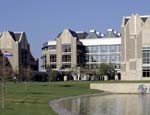 (Photo: Assassi Productions) The Medtronic World Headquarters is a blend of traditional and modern architecture; local limestone and sand-molded brick were chosen for their natural, earth-hewn qualities and connection to Minnesota.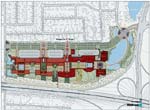 Site plan Site plan (Photo: Assassi Productions) The main driveway passes a 6-acre pond in front of the Biomaterials and Life Sciences Research Building (right) and the Education Center (left).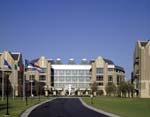 (Photo: Assassi Productions) The entry courtyard establishes a collegiate environment for the campus.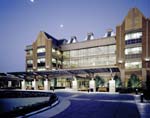 (Photo: Assassi Productions) The main entry court; the soaring atrium is topped by skylight monitors.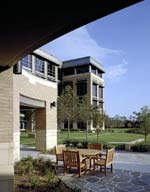 (Photo: Assassi Productions) The outdoor dining terrace faces south and opens up to the main courtyard.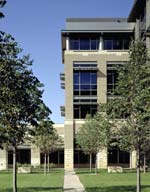 (Photo: Assassi Productions) Courtyards include trees, paths and stone benches, and are surrounded by covered walkways.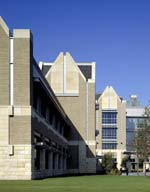 (Photo: Assassi Productions) The exterior is detailed in limestone, sand molded brick, and warm-toned metals.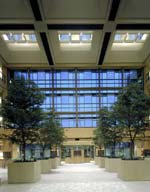 (Photo: Assassi Productions) The 90-foot-square central atrium serves as an indoor commons for the entire campus.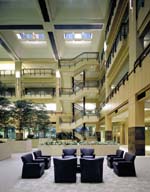 (Photo: Assassi Productions) The open stair links all four levels of the facility.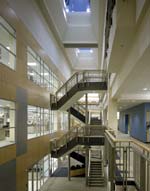 (Photo: Assassi Productions) The laboratories on all three levels of the BioMedical Laboratory building on the left are viewed and served from the office space located on the right.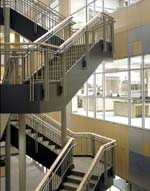 (Photo: Assassi Productions) The double helix stair in the BioMedical Laboratory links the office and lab areas.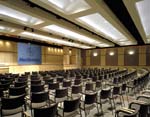 (Photo: Assassi Productions) The main auditorium seats 250 and is used for both educational and dining events.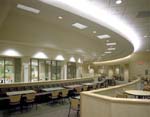 (Photo: Assassi Productions) The employee dining room connects to the outdoor dining terrace. Plan 1 Plan 1 Plan2 Plan2 |
© 2002 ArchNewsNow.com